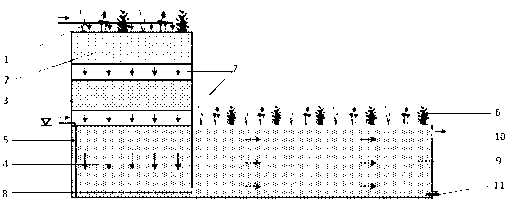Method for treating domestic wastewater with combined laminated vertical flow-horizontal subsurface flow wetland
A technology of vertical flow wetland and horizontal subsurface flow, applied in the field of stacked vertical flow-horizontal subsurface flow combined wetland treatment of domestic sewage, can solve the problems of unsmooth nitrification-denitrification pathway, limited oxidation capacity, odor in effluent, etc. Effects of aerobic microbial activity, enhanced hydraulic conductivity, and improved treatment efficiency
- Summary
- Abstract
- Description
- Claims
- Application Information
AI Technical Summary
Problems solved by technology
Method used
Image
Examples
Embodiment 1
[0039] The laminated vertical flow-horizontal subsurface flow combined wetland is constructed in a certain area along the Dongjiang River for the treatment of domestic sewage. After the sewage passes through the coarse screen and the fine screen, it is lifted by the water pump into the cascading vertical flow wetland, sprinkled from the top, and enters three filter bed modules step by step from top to bottom for treatment, and the sewage reaches the bottom layer of the cascading vertical flow wetland Finally, through the perforated flower wall set at the bottom of the cascading vertical flow wetland, it enters the next level of horizontal subsurface flow wetland for further purification treatment, and finally the water comes out from the upper end of the horizontal subsurface flow wetland. The design parameters of each component of the laminated vertical flow-horizontal subsurface flow combined wetland are as follows:
[0040] The design processing capacity is 24m3 / d.
[0041...
PUM
| Property | Measurement | Unit |
|---|---|---|
| height | aaaaa | aaaaa |
| thickness | aaaaa | aaaaa |
| thickness | aaaaa | aaaaa |
Abstract
Description
Claims
Application Information
 Login to View More
Login to View More - R&D
- Intellectual Property
- Life Sciences
- Materials
- Tech Scout
- Unparalleled Data Quality
- Higher Quality Content
- 60% Fewer Hallucinations
Browse by: Latest US Patents, China's latest patents, Technical Efficacy Thesaurus, Application Domain, Technology Topic, Popular Technical Reports.
© 2025 PatSnap. All rights reserved.Legal|Privacy policy|Modern Slavery Act Transparency Statement|Sitemap|About US| Contact US: help@patsnap.com



